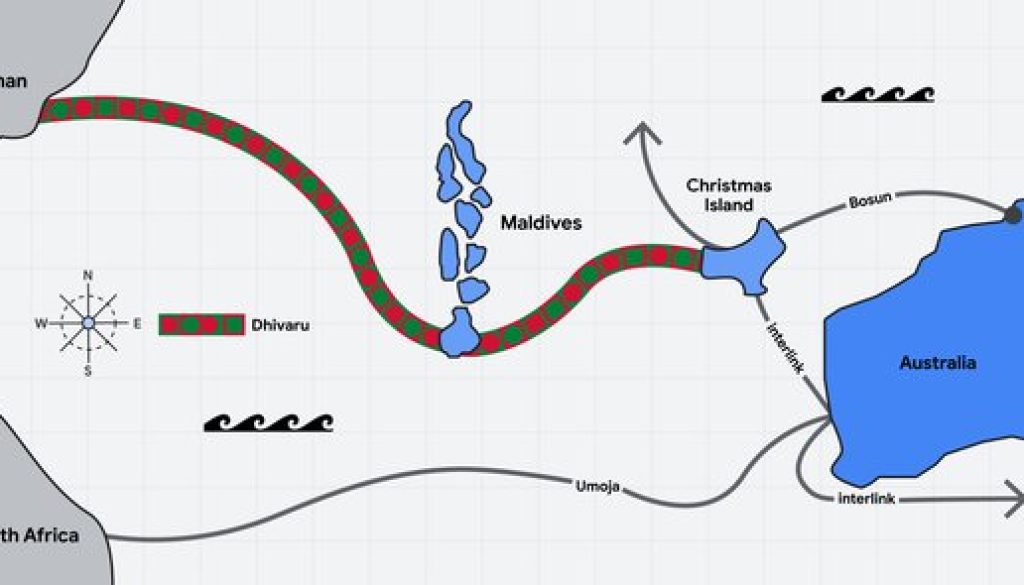GCP – Introducing Dhivaru and two new connectivity hubs
Today, we’re announcing Dhivaru, a new Trans-Indian Ocean subsea cable system that will connect the Maldives, Christmas Island and Oman. This investment will build on the Australia Connect initiative, furthering the reach, reliability, and resilience of digital connectivity across the Indian Ocean.
Reach, reliability and resilience are integral to the success of AI-driven services for our users and customers. Tremendous adoption of groundbreaking services such as Gemini 2.5 Flash Image (aka Nano Banana) and Vertex AI, mean resilient connectivity has never been more important for our users. The speed of AI adoption is also outpacing anyone’s predictions, and Google is investing to meet this long-term demand.
“Dhivaru” is the line that controls the main sail on traditional Maldivian sailing vessels, and signifies the skill, strength, and experience of the early sailors navigating the seas.

In addition to the cable investment, Google will be investing in creating two new connectivity hubs for the region. The Maldives and Christmas Island are naturally positioned for connectivity hubs to help improve digital connectivity for the region, including Africa, the Middle East, South Asia and Oceania.
“Google’s decision to invest in the Maldives is a strong signal of confidence in our country’s stable and open investment environment, and a direct contribution to my vision for a diversified, inclusive, and digitized Maldivian economy. As the world moves rapidly toward an era defined by digital transformation and artificial intelligence, this project reflects how the Maldives is positioning itself at the crossroads of global connectivity — leveraging our strategic geography to create new economic opportunities for our people and to participate meaningfully in the future of the global economy.” – His Excellency the President of Republic of Maldives
“We are delighted to partner with Google on this landmark initiative to establish a new connectivity hub in the Maldives. This project represents a major step forward in strengthening the nation’s digital infrastructure and enabling the next wave of digital transformation. As a leading digital provider, Ooredoo Maldives continues to expand world-class connectivity and digital services nationwide. This progress opens new opportunities for businesses such as tourism, enabling smarter operations, improved customer experiences and greater global reach. We are proud to be powering the next phase of the Digital Maldives.” – Ooredoo Maldives CEO and MD, Khalid Al Hamadi.
“Dhiraagu is committed to advancing the digital connectivity of the Maldives and empowering our people, communities, and businesses. Over the years, we have made significant investments in building robust subsea cable systems — transforming the digital landscape — connecting the Maldives to the rest of the world and enabling the rollout of high-speed broadband across the nation. We are proud and excited to partner with Google on their expansion of subsea infrastructure and the establishment of a new connectivity hub in Addu City, the southernmost city of the Maldives. This strategic collaboration with one of the world’s largest tech players marks another milestone in strengthening the nation’s presence within the global subsea infrastructure, and further enhances the reliability and resiliency of our digital ecosystem.” – Ismail Rasheed, CEO & MD, DHIRAAGU
Connectivity hubs for the Indian Ocean region
Connectivity hubs are strategic investments designed to future-proof regional connectivity and accelerate the delivery of next-generation services through three core capabilities: Cable switching, content caching, and colocation.
Cable switching: Delivering seamless resilience
Google carefully selects the locations for our connectivity hubs to minimize the distance data has to travel before it has a chance to ‘switch paths’.. This capability improves resilience, and ensures robust, high-availability connectivity across the region. The hubs also allow automatic re-routing of traffic between multiple cables. If one cable experiences a fault, traffic will automatically select the next best path and continue on its way. This ensures high availability not only for the host country, but minimizes downtime for services and users across the region.
Content caching: Accelerating digital services
Low latency is critical for optimal user experience. One of Google’s objectives is to serve content from as close to our users and customers as possible. By caching — storing copies of the most popular content locally — Google can reduce the latency to retrieve or view this content, improving the quality of services.
Colocation: Fostering a local ecosystem
Connectivity hubs are often in locations where users have limited access to high quality data centers to house their services and IT hardware, such as islands. Although these facilities are not very large as compared to a Google data center, Google understands the benefits of shared infrastructure, and is committed to providing rack space to carriers and local companies.
Energy efficiency
Subsea cables are very energy efficient. As a result, even when supporting multiple cables, content storage and colocation, a Google connectivity hub requires far less power than a typical data center. They are primarily focused on networking and localized storage and not the large demands supporting AI, cloud and other important building blocks of the Internet. Of course, the power required for a connectivity hub can still be a lot for some smaller locations, and where it is, Google is exploring using its power demand to accelerate local investment in sustainable energy generation, consistent with its long history of stimulating renewable energy solutions.
These new connectivity hubs in the Maldives and Christmas Island are ideally situated to deepen the resilience of internet infrastructure in the Indian Ocean Region. The facilities will help power our products, strengthen local economies and bring AI benefits to people and businesses around the world. We look forward to announcing future subsea cables and connectivity hubs and further enhancing the Internet’s reach, reliability, and resilience.
Read More for the details.


